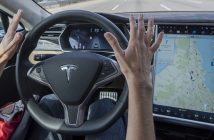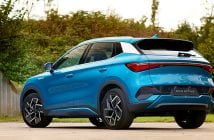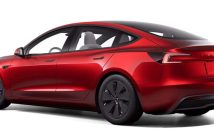+++ According to statistics from Late Finance, BYD makes an average net profit of 9.000 yuan per car. That’s about $1.250. Tesla on the other hand made over $8.250 per car based on net profit of 14.9 billion dollars and sales of 1.81 million cars in 2023. What this clearly shows is that BYD is going after market share rather than profits. Such tactics are typical among Chinese businesses where a ‘race to the bottom, winner takes all’ mentality pervades. Good examples have been bicycle sharing schemes, food delivery and to a lesser extent ride hailing schemes. All initially had multiple entrants who then undertook huge discounting and promotions in order to gain market share. With bicycle sharing this largely whittled the competition down to 2 companies: Ofo and Mobike. The result though was that due to relentless competition they had created a business model that was not profitable and neither company exists anymore, although there are still a handful of bicycle sharing companies. We are seeing a similar story in the Chinese car market where since last year there has been huge discounting from brands. China for a long time has had too many producers and too many brands, and the average factory utilization rate is 59%. A healthy range is generally considered to be 70-80%. With NEVs (New Energy Vehicles like full-electric and plug-in hybrid cars) it is rapidly becoming BYD and then everyone else. BYD last year sold 2.706.075 cars in China, the next highest was Tesla at 603.664. By the time you get down to 10th place sales are only 144.155 from Leapmotor. BYD is setting the agenda thanks to its ability to sell large numbers of cars at low prices. Despite the low profit level in 2023, BYD has actually increased its profit levels over previous years. Since the end of 2019 BYD’s cash reserves have increased by 8 times. Before 2021 the net profit per car was actually negative. Although last year’s profit per car was relatively low it was still significantly higher than the 5.600 yuan ($750) per car in 2022. Do car companies want market share or single car profits? BYD has the luxury thanks to economies of scale and its vertical integration to lead when it comes to pricing. For many other companies (particularly in the NEV market, but also in the market in general), the single car profit might literally be 1 car due to the low sales. From the beginning of this year, BYD has fired a new salvo in the price war and has switched from an NEV the same price as ICE model to NEV cheaper than ICE tactic. Sales for March were the second highest monthly figures achieved by BYD, the highest record being in December 2023, and saw sales once again break the 300.000 level for a month. +++
+++ Shares of electric vehicle startups Rivian and Lucid closed at all-time lows after FORD slashed prices on its electric pickup truck. The industrywide price war on electric autos is a major concern for investors. For unprofitable startups like Rivian and Lucid, it threatens to further delay when they might start making money. Rivian closed down 6.8% to $9.57, slipping below $10 for the first time since it went public in November 2021. Lucid fell 5.7% to $2.50, also its lowest close ever. +++
+++ The Hyundai Motor Group plans to expand operations at its HTWO Guangzhou facility (its first overseas hydrogen fuel cell system production plant) by initiating pilot projects for commercial HYDROGEN fuel cell vehicles this year. Lee Hyuk-joon, executive vice president of Hyundai Motor Group China, detailed the initiative at the 10th Annual Guangzhou International Investment Conference. Hyundai HTWO is a dedicated brand created by the Hyundai Motor Group to represent their hydrogen fuel cell technology. The focus of Hyundai’s efforts in Guangzhou is to elevate the city to become one of the world’s major centers for hydrogen energy, working in close partnership with local stakeholders. Hyundai plans to disclose further details of upcoming projects with the Guangzhou government to enhance the worldwide hydrogen energy network. HTWO Guangzhou is already making strides with its pilot projects aimed at promoting hydrogen fuel cell vehicles. In the past year, it announced plans to deliver 1.500 hydrogen-powered commercial vehicles, including trucks and cleaning vehicles, to public enterprises in Guangdong Province and Guangzhou City. The initiative is supported by the Guangdong provincial government’s introduction of investment-friendly policies. These reforms are designed to boost the manufacturing sector’s competitiveness and enhance the overall investment climate. Foreign direct investment in Guangzhou reached 48.22 billion yuan ($666.3 million) last year, and over 1.000 new foreign-invested companies were established in just the first 2 months of this year, marking an increase of 56.7 percent compared to the previous year. The demand for hydrogen vehicles in China has grown rapidly, with Guangzhou leading the surge. It is projected that by 2035, China will host one of the largest hydrogen electric vehicle markets globally. In line with this, the China Society of Automotive Engineers released the Energy-saving and New Energy Vehicle Technology Roadmap 2.0 in October 2020, which targets the deployment of 1 million hydrogen electric vehicles, primarily commercial, by 2035. HTWO Guangzhou began operations in June last year and is capable of producing 6,500 hydrogen fuel cell systems annually. +++
+++ A recent report by the Boston Consulting Group indicates that the HYUNDAI IONIQ 6 stands out as the sole electric vehicle (EV) in the U.S. market, meeting the median price, range, and charging criteria desired by potential buyers. Surveying 3.000 consumers, the firm found that requirements for mainstream EV adoption include 20-minute charging times, 30-minute detours for fast-charging stations, a range of 560 km, and a price of $50.000. Equipped with fast-charging technology, the Hyundai IONIQ 6 can charge from 10% to 80% in just 18 minutes and 30 seconds and travel approximately 580 km on a single charge. Starting at $38.615, the 2024 model is $4.100 cheaper than its predecessor. Following closely is Tesla’s Model 3, which starts at $38.990 with a range of up to 450 km. The Long Range model starts at $47.740 with a range of up to 545 km. According to BCG research, while only 6% of surveyed consumers currently own an EV, 38% intend to purchase one as their next vehicle, with an additional 27% considering it for the future. However, meeting customer expectations will require support from policymakers and the charging infrastructure. BCG projects that EV sales could constitute up to 30% of U.S. sales when next-generation EVs reach full production, with a more realistic estimate placing market share around 20%. One of the primary challenges for original equipment manufacturers (OEMs) is producing the next generation of EVs profitably. BCG estimates that most OEMs currently incur losses of approximately $6,000 on each EV sold for $50,000 after factoring in customer tax credits. +++
+++ Hyundai and Kia will use battery cells produced by a local company in INDIA for their future EVs sold in the West Asian country, a move to increase their presence in the blossoming Indian EV market, the carmakers said. The car-making firms of the Hyundai Motor Group said they signed a strategic cooperation agreement for local production of battery cells for India-specific EVs with India’s battery maker Exide Energy, at their R&D center in Hwaseong. Exide Energy is a subsidiary of Exide, a leading battery company in the Indian lead-acid battery market, which has been active there for over 75 years. Exide Energy aims to start the pilot production of EV battery cells as early as the end of the year. Initially, Exide Energy will develop and produce lithium iron phosphate (LFP) battery cells, which will be supplied to Hyundai and Kia’s production bases in India. The battery cells from Exide Energy will be equipped in their future India-specific EVs, marking the first EVs to use locally produced batteries. The agreement covers the carmakers’ India-only EVs, diversifying battery sources and strengthening the responsiveness of India’s EV market, which is set to grow even larger in the near future, the Korean carmakers said. “Hyundai and Kia will pursue joint cooperation for the development and production of battery cells that will be used in Hyundai and Kia’s EVs, expand the partnership for electric models including EVs and hybrid electric vehicles (HEVs) and secure price competitiveness”, the carmakers said. Hyundai and Kia will cooperate with Exide Energy in all stages from development of batteries to mass production to ensure quality. Furthermore, the companies also plan to respond jointly to the Indian government’s EV policies. India, 1 of the top-3 car markets in the world, is considered a country actively pursuing an electrification strategy, including offering incentives to companies starting EV production on its soil. The Indian government also announced plans to expand the share of EV sales to 30 percent of total vehicle sales by 2030. Hyundai and Kia expect that EVs equipped with domestically produced batteries will become a favorable purchasing factor for Indian consumers. Also, they expect the partnership will decrease the risks of geopolitical uncertainties spreading across the global economy. “India is an important market where electrification is expected to expand in the future, and securing cost competitiveness through battery localization from the beginning is important”, said Yang Heui-won, president of Hyundai and Kia’s R&D division. “It is very meaningful that the upcoming India-specific EVs to be mass-produced in India will be the first EVs using batteries produced locally by an Indian company”. Hyundai previously announced plans to invest about 200 billion rupees ($2.4 billion) from 2023 over 10 years for the establishment of EV production facilities and infrastructure in India. In particular, by 2028, it aims to introduce 6 electric models and install a large number of EV charging stations. +++
+++ LEXUS has removed the LC sports cars from sale in Europe, which means it now sells only hybrids and EVs, and no longer offers a V8. The 2-door GT / Convertible was approaching the end of their expected life cycles anyway, at 7 years old, but a spokesperson for the brand cited “legislative and homologation issues” as the reason for their withdrawal. It is not clear, though, whether the decision was made in light of GSR2 safety regulations, the EU’s new cybersecurity directive or fleet emission quotas. The LC (Convertible) is no longer available in Europe. The withdrawal means Lexus’s European line-up is now mainly made up of SUVs, with just the ES and LS saloons and (in some countries) the LM (a MPV) remaining alongside the LBX, UX, NX, RX and RZ crossovers. It also means all Lexus models are electrified, with the firm’s naturally aspirated 5.0-litre V8 retiring along with the LC. That leaves the Ford Mustang as the only series-production car available with an atmo V8 in Europe. The LC has been on sale since 2017 with the choice of the pure V8 or an electrified 3.5-litre V6, receiving the option of a soft-top convertible in 2020. +++
+++ Tesla chief Elon MUSK will visit India this month to meet prime minister Narendra Modi and is expected to make an announcement on plans to invest and open a new factory in the country, two sources with direct knowledge said. The billionaire will meet Modi in the week of April 22 in New Delhi, and will separately make an announcement about his India plans, said the 2 sources, who declined to be named as the trip details are confidential. Musk would be visiting India just as it heads into a 2-month-long election with nearly a billion voters, starting April 19, in which Modi is widely seen winning a rare third term. A Tesla investment announcement during the election would bolster the business-friendly credentials of Modi, who has for years courted foreign companies to set up manufacturing operations in India and create jobs. The Tesla CEO will be accompanied by other executives during his visit, said the first source. Musk and Modi last met in New York in June, and Tesla for months lobbied India to lower import taxes on electric vehicles while it weighed up a factory there. India last month unveiled a new EV policy lowering import taxes to 15% from 100% on some models if a manufacturer invests at least $500 million and sets up a factory too. Tesla officials are expected to visit India this month to look at sites for a manufacturing plant that would require an investment of about $2 billion. Tesla has also begun production of right-hand drive cars at its German plant for export to India later this year, sources have said. Musk said this week on X that “India should have electric cars like every other country has electric cars. It’s a natural progression to provide Tesla electric vehicles in India”. Tesla’s push into India comes as slowing EV demand in its main U.S. and Chinese markets coincides with intensifying competition from Chinese automakers. Tesla reported a drop in first-quarter deliveries that missed analyst estimates. India’s EV market is small but growing and dominated by local carmaker Tata Motors. EVs made up just 2% of total car sales in 2023. The government is targeting 30% by 2030. +++
+++ March sales figures from RUSSIA show that Chinese brands now dominate the market holding 9 out of the top-10 best-selling brand positions with only homegrown champion Lada outselling them. Even more surprising is that one of those brands is Li Auto, which up until now was widely believed not to export cars. Russia last year was China’s largest car export market with sales of 841.000 from January to November 2023. According to figures from China Automotive Digital Research Institute this wave shows no sign of abating. Although sales of Lada far exceeded sales of any Chinese brand, and were up by 64.5% in March and by 43.2% Year-On-Year for the first 3 months, the increases from some Chinese brands were much higher. Great Wall’s Haval brand along with Geely, and Chery all achieved quite close results with sales of 16.045, 15.004 and 13.159 respectively in March. Both Geely and Chery in fact did even better as they appeared on the top-10 list more than once. In the case of Geely they also gained the number 9 position thanks to Geely Belgee which is a joint venture mainly controlled by Belarusian state automaker BelAZ (51.5%) and Geely (33.5%) with the remainder held by other Chinese entities. It should be noted though that these cars are actually made in Belarus rather than China. Chery on the other hand also had entries from the Exceed brand at number 6, Omoda at number 7 and Jetour at number 10. Omoda is an export only brand for various Chery cars first debuting with a renamed version of the Chery Omoda 5 and initially used as a brand in Russia and Kazakhstan. The biggest news however on the list is Li Auto a brand which is generally thought of as operating only in China. Li sold 3.617 cars in Russia during March which was a 1.4971% increase YOY and the brand sold 8.049 in the first quarter up by 19.532% The full results can be seen in the table below. These indicate that Russia will likely remain China’s key export market and that sales in Russia should be well up on last year and likely will amount to well over 1 million cars in 2024. +++
+++ TESLA will unveil its ‘Robotaxi’ on August 8, Elon Musk said in a post on social media platform X. Musk’s post followed a report, citing sources, that Tesla has canceled its long-promised inexpensive car, but will continue developing self-driving robotaxis on the same small-vehicle platform. Tesla is making a risky bet if it shifts efforts on its small-car vehicle platform to robotaxis as the successful introduction of vehicles that drive themselves is in the distant future, and the technology faces engineering and regulatory hurdles. On Wallstreet, investors are unsure what this will mean for Tesla long-term. +++



